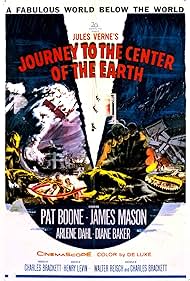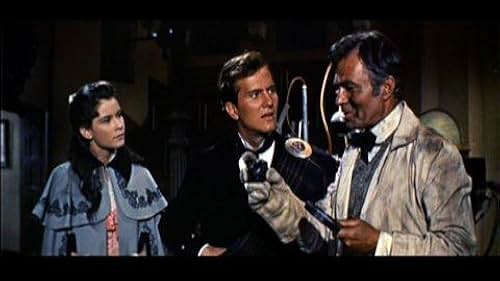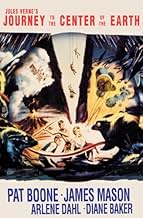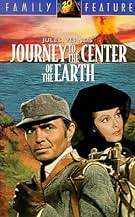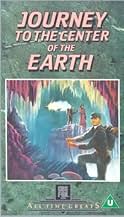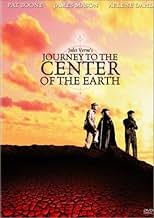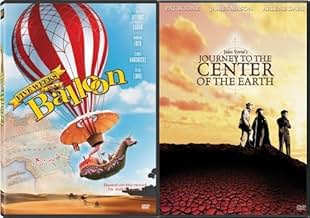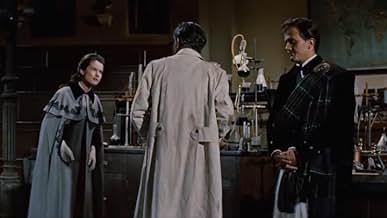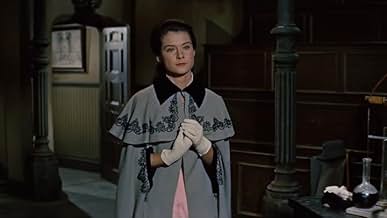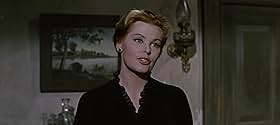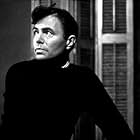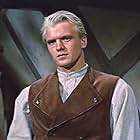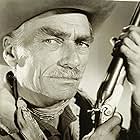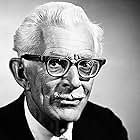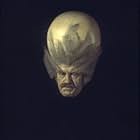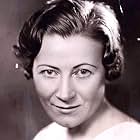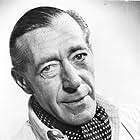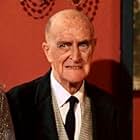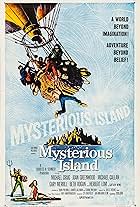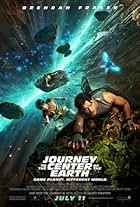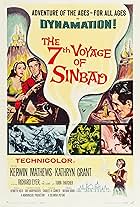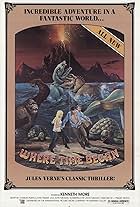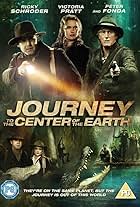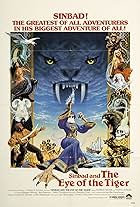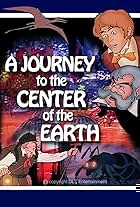An Edinburgh professor and assorted colleagues follow an explorer's trail down an extinct Icelandic volcano to the earth's center.An Edinburgh professor and assorted colleagues follow an explorer's trail down an extinct Icelandic volcano to the earth's center.An Edinburgh professor and assorted colleagues follow an explorer's trail down an extinct Icelandic volcano to the earth's center.
- Nominated for 3 Oscars
- 4 nominations total
Mary Brady
- Kirsty
- (uncredited)
Alan Caillou
- Rector
- (uncredited)
Gertrude the Duck
- Gertrude
- (uncredited)
John Epper
- Groom
- (uncredited)
Edith Evanson
- Innkeeper
- (uncredited)
Alex Finlayson
- Prof. Bayle
- (uncredited)
Molly Glessing
- News Vendor
- (uncredited)
Frederick Halliday
- Chancellor
- (uncredited)
Kendrick Huxham
- Scots Newsman
- (uncredited)
Owen McGiveney
- Shopkeeper
- (uncredited)
- Director
- Writers
- All cast & crew
- Production, box office & more at IMDbPro
Storyline
Did you know
- TriviaJames Mason reportedly had very little patience with Arlene Dahl's "movie star" preening. Their relationship off-screen was very much like their relationship on- screen.
- Goofs(at around 21 mins) Early in the movie, Oliver Lindenbrook speaks of the "stars and galaxies of outer space." In the 1880s, however, our Milky Way galaxy was believed to constitute the entire universe. Knowledge that other galaxies exist beyond our own did not come about till the 1920s. Thus a man of the 1880s would not use the word "galaxy" in its plural form.
- Quotes
Sir Oliver Lindenbrook: Are we to be abducted every day in Iceland?
- Alternate versionsIn some European versions of the film, for example the Spanish dubbing, the "Prof of Geology's Song" was re-dubbed into the "Gaudeamus Igitur" song.
- ConnectionsEdited into Attack of the 50 Foot Monster Mania (1999)
- SoundtracksMy Love is Like a Red, Red Rose
By Robert Burns
Set to music by Jimmy Van Heusen (as James Van Heusen)
Sung by Pat Boone
Featured review
I suppose the best way to appreciate a widescreen Cinemascope film is to have seen it on a large movie theater screen in the first place. I remember that day well, back in Brewster, NY, late 1959. My best friend David Vail and I were 7 years old apiece and thrilled at the prospect of being allowed to see the movie un-supervised (a very rare privilege) and the cavernous, dark movie theatre only heightened the sense of mysterium tremens. We felt as if we were fellow travellers, accompanying the Lindenbrook expedition on its mission to the center of the earth. Dimly aware that the film had scary elements, we vowed not to eat any of our limited budget sweets until a truly "scary" moment appeared. It took a while but it came. Many years later Spielberg and Lucas would pay homage to that moment in their throwback serial film "Indiana Jones: Raiders of the Lost Ark" but in the intervening years I have had recurring dreams about being chased by a boulder down a narrow passageway.
"A Journey to the Center of the Earth" is a movie I see over and over again. Chiefly because the story is compelling and true to the quasi whimsical and scientifically speculative writings of Jules Verne. What I find appealing about Verne is that he is free from the cynical and existential bindings that have fettered other illustrious but more contemporary science fiction writers. Verne goes about his business unshackled by theorems, proofs and devastating world wars. The industrial revolution is barely a generation old and science is making great leaps. Anything is possible; a trip to the moon, a long voyage undersea, a journey to the innermost recesses of our planet. While you watch the film it is easy to suspend your belief because you are forced to place yourself in the context of the Great Explorations. The story simply draws you in for the same reason the tale of Sir Ernest Shackleton draws you in or the accounts of the last days of Pompei; or, a superb story like Edgar Allen Poe's "The Gold Bug" draws you in.
Levin's treatment of the tale is excellent. This is one of those rare examples where the film is better than the book. The dour trio of three male expedition members in the book is replaced by a balanced quartet, adding a greater range of human interaction, a little sexual tension (without it condescending or demeaning ot the female character) and a side plot (the nefarious and righteous Count Saknussem). The preamble is longer and the conceit of using a plumb line as the key element (McGuffin if) you will) is a stroke of narrative genius. The movie loses no momentum by investing time in character development and the the reasons for setting up the expedition. James Mason is perfect as the obsessed scientist. Pat Boone does a fairly good job as the "leading man" and male ingenue. Arlene Dahl is sophisticated and her Scandinavian background gives her role credibility. Hans in probably the only movie role he ever played is more than adequate as the practical, strong man. then there's Gertrude, played well by... a duck.
The story is well paced, nuanced and served well by a stunning score by one of the true masters of mood: Bernard Herrmann. At times airy and light the music also comments brilliantly on the action via horn arrangements and sultry, chilling cellos that give a a deep sense of foreboding.
On a deeply personal level I have in a strange way often compared this movie to the restlessness of the human spirit. Not merely the desire to physically travel, explore and report back from unknown regions but in the spiritual sense: to unravel the mystery of the self. As a 7 year old I would ponder the great inponderables, life, death, God, the meaning of existence and somehow this movie, cheesy special effects and all, has given me haunting sign posts that the only true travel is the voyage within. So, in a symbolic way, A Journey to the Center of the Earth is the moviegoer's experience of the vast uncharted regions of our deeper self. I know most readers will dismiss these "adumbrations" of the personal "cave" within but I leave you with a few lines from a song that was popular in 1959...
I know, beyond a doubt my heart will lead me there, soon we'll meet, I know we'll meet beyond the shore we'll kiss just like before and happy we'll be beyond the sea and never again, will I go sailing no more sailing.
A Journey to the Center of the Earth has adventure, whimsy and moments of awe with unexpected twists. The characters are at the mercy of the caprices of the nether regions. At times you feel as if the characters are journeying through unpopulated Dantesque landscapes, other times through the richness of primordial and unspoiled prehistoric settings. The voyagers start off darkly in the early teluric going and then by degrees the subterranean world glistens in a unexpected reversal of all that we are led to believe exists below our feet. The variety of visual delights is breathtaking.
This is my favourite film of all time. I have seen it 40-50 times and always find a detail or two at each screening that is imaginative and inspiring. See it if you can in wide screen. You will appreciate it more.
"A Journey to the Center of the Earth" is a movie I see over and over again. Chiefly because the story is compelling and true to the quasi whimsical and scientifically speculative writings of Jules Verne. What I find appealing about Verne is that he is free from the cynical and existential bindings that have fettered other illustrious but more contemporary science fiction writers. Verne goes about his business unshackled by theorems, proofs and devastating world wars. The industrial revolution is barely a generation old and science is making great leaps. Anything is possible; a trip to the moon, a long voyage undersea, a journey to the innermost recesses of our planet. While you watch the film it is easy to suspend your belief because you are forced to place yourself in the context of the Great Explorations. The story simply draws you in for the same reason the tale of Sir Ernest Shackleton draws you in or the accounts of the last days of Pompei; or, a superb story like Edgar Allen Poe's "The Gold Bug" draws you in.
Levin's treatment of the tale is excellent. This is one of those rare examples where the film is better than the book. The dour trio of three male expedition members in the book is replaced by a balanced quartet, adding a greater range of human interaction, a little sexual tension (without it condescending or demeaning ot the female character) and a side plot (the nefarious and righteous Count Saknussem). The preamble is longer and the conceit of using a plumb line as the key element (McGuffin if) you will) is a stroke of narrative genius. The movie loses no momentum by investing time in character development and the the reasons for setting up the expedition. James Mason is perfect as the obsessed scientist. Pat Boone does a fairly good job as the "leading man" and male ingenue. Arlene Dahl is sophisticated and her Scandinavian background gives her role credibility. Hans in probably the only movie role he ever played is more than adequate as the practical, strong man. then there's Gertrude, played well by... a duck.
The story is well paced, nuanced and served well by a stunning score by one of the true masters of mood: Bernard Herrmann. At times airy and light the music also comments brilliantly on the action via horn arrangements and sultry, chilling cellos that give a a deep sense of foreboding.
On a deeply personal level I have in a strange way often compared this movie to the restlessness of the human spirit. Not merely the desire to physically travel, explore and report back from unknown regions but in the spiritual sense: to unravel the mystery of the self. As a 7 year old I would ponder the great inponderables, life, death, God, the meaning of existence and somehow this movie, cheesy special effects and all, has given me haunting sign posts that the only true travel is the voyage within. So, in a symbolic way, A Journey to the Center of the Earth is the moviegoer's experience of the vast uncharted regions of our deeper self. I know most readers will dismiss these "adumbrations" of the personal "cave" within but I leave you with a few lines from a song that was popular in 1959...
I know, beyond a doubt my heart will lead me there, soon we'll meet, I know we'll meet beyond the shore we'll kiss just like before and happy we'll be beyond the sea and never again, will I go sailing no more sailing.
A Journey to the Center of the Earth has adventure, whimsy and moments of awe with unexpected twists. The characters are at the mercy of the caprices of the nether regions. At times you feel as if the characters are journeying through unpopulated Dantesque landscapes, other times through the richness of primordial and unspoiled prehistoric settings. The voyagers start off darkly in the early teluric going and then by degrees the subterranean world glistens in a unexpected reversal of all that we are led to believe exists below our feet. The variety of visual delights is breathtaking.
This is my favourite film of all time. I have seen it 40-50 times and always find a detail or two at each screening that is imaginative and inspiring. See it if you can in wide screen. You will appreciate it more.
- Dan Sandford
- Jul 23, 2002
- Permalink
- How long is Journey to the Center of the Earth?Powered by Alexa
Details
- Release date
- Country of origin
- Languages
- Also known as
- Put u srediste Zemlje
- Filming locations
- Carlsbad Caverns National Park - 727 Carlsbad Caverns Highway, Carlsbad, New Mexico, USA(the center of the earth)
- Production companies
- See more company credits at IMDbPro
Box office
- Budget
- $3,440,000 (estimated)
- Runtime2 hours 9 minutes
- Color
- Aspect ratio
- 2.35 : 1
Contribute to this page
Suggest an edit or add missing content

Top Gap
By what name was Journey to the Center of the Earth (1959) officially released in India in Hindi?
Answer